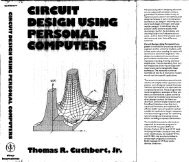Systems Reference Library IBM 1800 System Summary
Systems Reference Library IBM 1800 System Summary
Systems Reference Library IBM 1800 System Summary
You also want an ePaper? Increase the reach of your titles
YUMPU automatically turns print PDFs into web optimized ePapers that Google loves.
Customer input signals are routed through terminals,<br />
signal conditioning elements, multiplexer<br />
switches, a differential amplifier, and into the analogto-digital<br />
converter. The output of the ADC is presented<br />
to the processor-controller via programmed<br />
II0 control or the data channel from the ADC output<br />
register.<br />
The major features that accomplish the analog<br />
input function are briefly introduced below. More detailed<br />
descriptions are given in the <strong><strong>System</strong>s</strong> <strong>Reference</strong><br />
<strong>Library</strong> publication, <strong>IBM</strong> <strong>1800</strong> Functional Characteristics,<br />
Form A26-5918. Figure 3 illustrates the interrelationship<br />
of each of the features. There are two<br />
models of the <strong>IBM</strong> 1851 Multiplexer Terminal. The<br />
model 1 provides for insertion of up to 64 multiplexer<br />
points in groups of 16 points. Customer wires are terminated<br />
on screw-down terminals. Different types of<br />
signal matching elements are available for each multiplexer<br />
point used. The elements are mounted in the<br />
multiplexer terminal. Up to two differential amplifiers<br />
can also be mOlUlted in each terminal.<br />
The model 2 is modified to allow for thermal<br />
measurement of the terminals. Thus, thermocouple<br />
wires can be directly connected to the terminals, and<br />
the cold-junction temperature can be read by the<br />
P-C. The maximum capacity of the model 2 is 62<br />
customer terminations.<br />
All other functions of the model 2 terminal are<br />
the same as the model 1 terminal. Thus nonthermocouple<br />
signals may 1;\lso be terminated in the<br />
model 2.<br />
Multiplexer/R: This feature provides relay (R)<br />
multiplexing with high input impedance (greater than<br />
ten megohms). high common-mode voltage operation<br />
(200 volts) and high common-mode rejection. Highand<br />
low-level analog inputs are switched at a maximum<br />
speed of 100 points per second. The equipment<br />
is card mOlUlted and plugs into the multiplexer terminal<br />
in groups of 16. For low-level signals, up to<br />
16 groups can be combined to form the input to one<br />
differential amplifier providing up to 256 input points<br />
per amplifier. Each amplifier has a fixed gain, and<br />
the full-scale input range for any group of relay<br />
multiplexer pOints is dependent on the gain of the<br />
amplifier to which it is connected. Gains available<br />
are 500, 250, 100, 50, 25, and 10. High-level inputs<br />
(-0.5 to +5 volts) do not require an amplifier. Up<br />
to 256 high-level points can be included on any ADC<br />
in the system.<br />
The multiplexer overlap feature allows overlapping<br />
of switching times for the multiplexer and<br />
solid-state multiplexer points.<br />
The maximum 100 point-per-second multiplexing<br />
rate applies randomly, while 50 point-per-second<br />
applies as a repetition rate on anyone point. To<br />
meet the common-mode rejection ratio specification,<br />
the repetition rate for anyone point should not exceed<br />
three samples per second.<br />
Multiplexer/S: This feature provides for solid-state<br />
(S) multiplexing of high-level single-ended analog<br />
inputs. Input sampling rates up to 24 kHz are possible<br />
with the mod 2 ADC. The multiplexer overlap<br />
feature allows the overlapping of relay and solidstate<br />
within any single-ADC system. Solid-state<br />
groups are mOlUlted in the model 1 multiplexer terminal<br />
and cannot be intermixed with relay multiplexer<br />
points within a terminal.<br />
The input voltage range is 0 to ±5 volts full<br />
scale.<br />
Multiplexer/R Control and Multiplexer/R Control<br />
Additional: These features provide the necessary<br />
control circuitry to operate the relay multiplexer<br />
points. Each feature can control up to 256 points.<br />
Multiplexer/S Control: Control circuitry to operate<br />
the solid-state multiplexer points is provided by this<br />
feature.<br />
Multiplexer Overlap: This feature allows the operations<br />
of multiplexer!R and miltiplexer/S to be overlapped.<br />
(Note: Overlap of multiplexer/R operations<br />
with other operations for multiplexer/R is not<br />
possible. )<br />
Overlapping can occur without the multiplexer<br />
overlap special feature under these conditions:<br />
1. Under programmed control, solid-state conversions<br />
can be performed while a relay point is<br />
being selected.<br />
2. If a discrete conversion of a relay point is<br />
started (a relay point is being selected) under programmed<br />
control, a sequence of conversions of<br />
solid-state pOints can be started on data channels.<br />
With the multiplexer overlap special feature,<br />
another means of overlapping is possible. Under twodata-channel<br />
operation, relay addresses can be interleaved<br />
with solid-state multiplexer addresses.<br />
Signal Conditioning Functions: The signal conditioning<br />
features that are available provide for:<br />
1. Conversion of 4 to 20 milliampere signals into<br />
either 0.1 to 0.5 volt or 1 to 5 volt input signals.<br />
2. Low-pass, passive filtering, to reject normalmode<br />
ac noise (for multiplexer/R only).<br />
<strong>System</strong> Units and Features 5

















